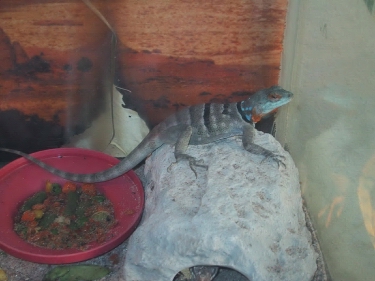
Baja blue rock lizards have a flattened body, and a spraddle legged stance that helps them climb over the rock surfaces of their habitat. They have no trouble climbing vertical, perpendicular, horizontal, and even upside down. No longer legally imported, the only way to get one is through a breeder. It's color can be very vibrant. The head and tail are powder blue. They have several powder blue spots on the nape. On the upper mid body, there are three dark bands, and lighter ones on the lower half. Around the eyes the color is yellow. The throat is also yellow, extending to the chest, with a dark blue center. The back is a gray base, with some blue and splashes of yellow bordering the bands. In gravid females, all the yellow turns orange. Males may reach 18 inches, and females grow to about a foot in length. These animals are flighty, and do not like to be handled. When handled, they make a loud throat popping sound, and attempt to bite.
FEEDING
They eat crickets, grasshoppers and other invertabrate. Mine love super worms. I occasionally feed mine pink mice. They may also eat smaller lizards. According to several sources, they also eat dandelions and other blossoms, and some fruit.
CAGING
At least a 55 to 75 gallon enclosure is a must for a tio ( only one male) . Bigger is always better. These lizard love to climb, so height is as important as length. I provide mine with bark, or fake rock (home made) all along three sides of the enclosure. They spend most of the time on the walls. Provide piles of immovable rocks for basking and hiding.
HEAT AND WATER
Temperatures may reach 110 to 115 F under the basking lights, with cooler areas to retreat to. I use a mini drip system, which drips water slowly into a water bowl. This stimulates them to drink, but doesn't rais the humidity too much for this desert species.
SEXING AND BREEDING
Sexing may not be easy. Males and females are both very colorful. Mature males have a thicker tail base, and a bigger head. Femoral pores are also bigger on mature males. To breed them, you will probably have to cool them down in the winter (brumation) . When females are ready to breed, and when they are gravid, they display orange coloration. Make sure to provide a nest box. Females will become very territorial before they lay eggs. Incubate the eggs between 85 to 88 F. The humidity should be low, refer to collard lizard egg incubation.



